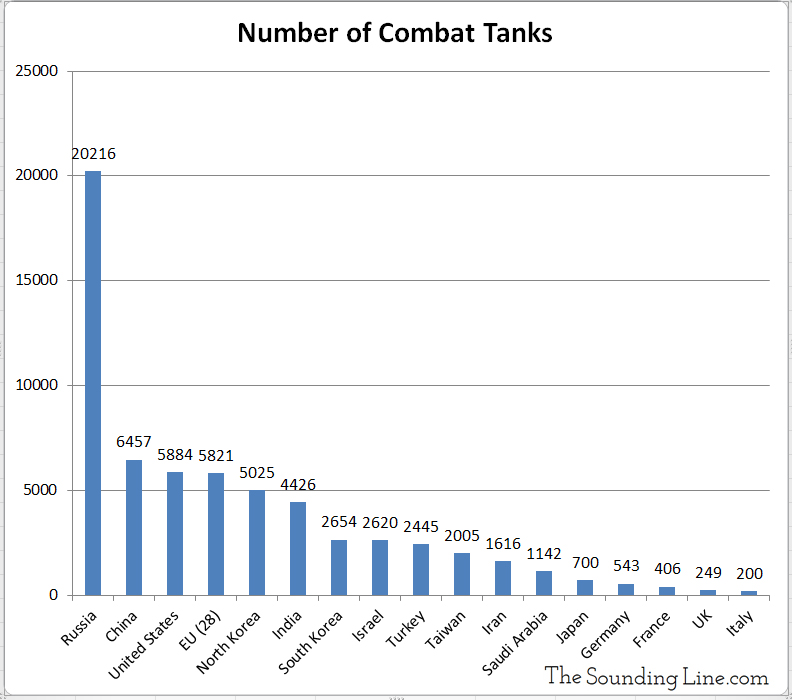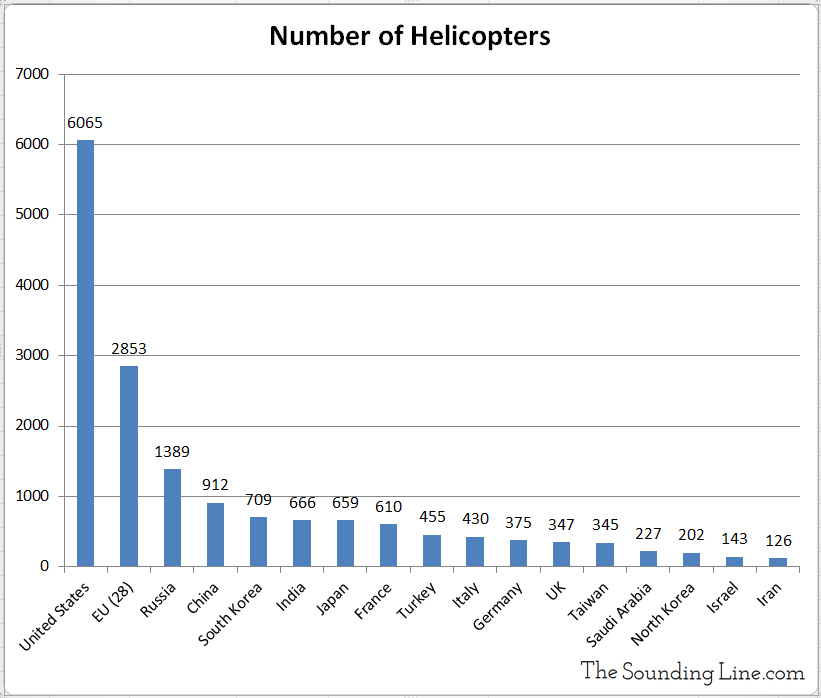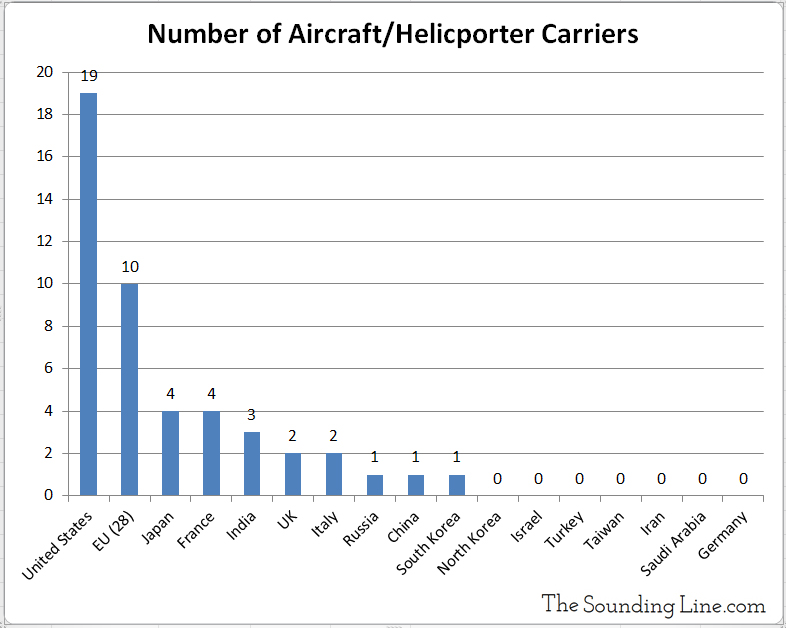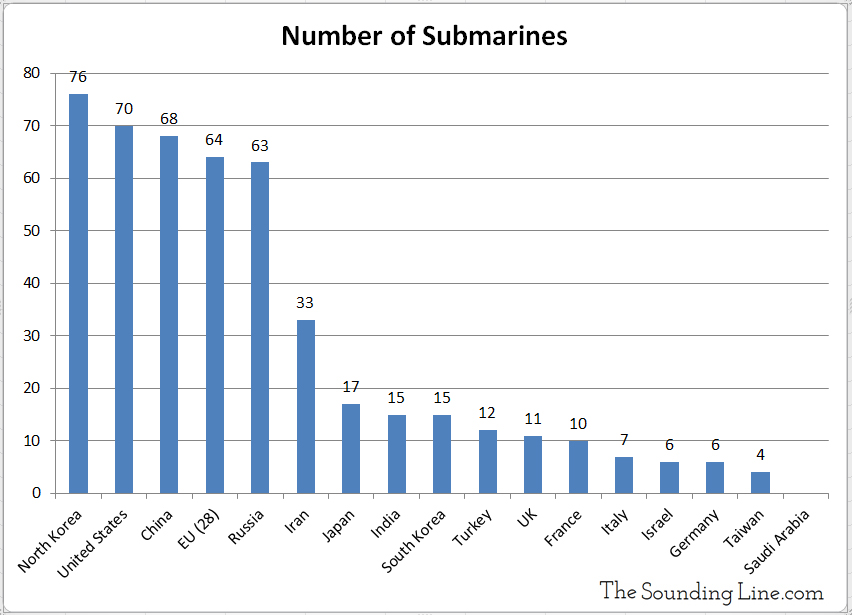Submitted by Taps Coogan on the 1st of September 2017 to The Sounding Line.
Enjoy The Sounding Line? Click here to subscribe for free.
Enjoy The Sounding Line? Click here to subscribe.
We recently came across the website Global Fire Power which, in addition to being an interesting read, contains a trove of information regarding the quantity of military equipment (tanks, helicopters, destroyers etc..) in service by militaries around the world. While we can’t speak to the accuracy of the various strength comparison metrics used by the website to compare the overall military power of different countries, the raw numbers of equipment attributed to various countries seem to be reasonably accurate. Thus, we have compiled a collection of charts based on this data that illustrate some of the large themes in the quantity of equipment in service by conventional military forces around the world.
To be very clear, these charts make no distinction between the quality or capability of equipment listed. North Korean submarines are obviously not equivalent to US submarines and the same likely goes for all of the other equipment listed. Nonetheless, the enormity of the difference in sheer numbers, and diminished technological difference between many of the countries’ equipment, make the observations worth noting.
Combat Tanks:
Overwhelmingly, Russia has the largest combat tank force in the world with over 20,200 tanks in service. By comparison, China has 6,457 and the US has 5,884. All of the countries in the EU combined have 5,821, just surpassing North Korea with a surprisingly large fleet of 5,025. Once great conventional military powers, France and the UK have just 406 and 249 respectively.

Helicopters:
Turning to helicopters, the advantage shifts from Russia to the US. The US military has over 6,000 helicopters, followed by the EU at 2,853, and Russia at 1,389.

Aircraft:
Similar trends persist when looking at military aircraft more broadly (including attack, fighter, strike, bomber, support and trainer aircraft, as well as helicopters, etc.). The US leads the world with 13,762 aircraft, followed by the EU at 6,731, then Russia at 3,794, and China at 2,955.

Aircraft/Helicopter Carriers:
In terms of aircraft and helicopter carriers, the US takes the lead again with 19 of the largest and most expensive pieces of military equipment in the world, followed by the EU with ten, and then Japan and France with four each (though Japan’s are exclusively helicopter carriers).

Destroyers:
In terms of naval destroyers, the US again takes the lead with 63, followed by Japan with 42, and China with 35. Once great conventional military powers, France and the UK have just four and six respectively.

Submarines:
Finally looking at submarines, surprisingly, North Korea has the most with 76, followed by the US with 70, China with 68, the combined EU with 64, and Russia with 63. It should be noted, that North Korea’s submarines are highly obsolete and have at times been described as ‘a big joke.’

Taken together these chart highlight a few important themes:
Russia maintains, overwhelmingly, the largest tank fleet in the world, dwarfing all others, and continues to develop state of the art tanks. Russia clearly sees itself as a major land power and has invested in the equipment to back that claim up.
In addition to possessing the overall best equipped military in the world, the US maintains by far the largest naval and aircraft fleets in the world and continues to push the state of the art in both fields.
While the EU ranks modestly well in terms of the combined equipment of all 28 countries, particularly in terms of aircraft, it is probably a stretch to count these forces together. The largest military spender in the EU, the UK, is already on its way out of the Union. Other existential political risks to the EU abound from Italy, to Greece, to Hungary. Furthermore, the EU militaries are not meaningfully integrated under EU command, but are instead integrated through NATO. For now, the EU remains a political, not military, union.
That brings us to the traditional European powers: the UK, France, and Germany. On an individual basis, each possess a quantity of military equipment more in line with countries such as Turkey or Taiwan, though presumably of higher quality. The UK has just 249 tanks to Russia’s 20,000, 856 aircraft to America’s 13,762, six destroyers to America’s 63. France and Germany are hardly better equipped. That these countries, which vied to be the most powerful militaries in the world less than 100 years ago, have essentially abandoned large conventional military power is profound. There exists a strong argument that this disarmament is perfectly rational. The idea that nuclear weapons have made conventional war impossible has become quite popular. France and the UK’s security is guaranteed by both their nuclear arsenals and NATO’s large conventional military forces. They, and all of their neighbors, are allied and members of the EU and/or NATO. The prospect of a major conventional western European war seems so remote as to be absurd. These countries’ equipment leaves them more than capable of executing counter-terrorism operations and military operations against non-peer military powers.
So why do the US, Russia, China, and other countries continue to maintain large conventional forces?
Because of the principal of mutually assured destruction, it is questionable that nuclear arsenals alone are an effective military option except in the case of the most extreme existential threats. For countries like the US, Russia, and China, which have diverse strategic interests around the world, there exists a range of conceivable military conflicts that do not constitute truly existential threats. Winning is of course still important, just not to the point of invoking their own obliteration via nuclear war.
When nuclear deterrence is your sole military option against other global powers (with whom mutually assured destruction is guaranteed), there isn’t a valid military option except to the gravest of existential threats and that option will assuredly lead to your destruction. For old European powers, any non-existential strategic interest opposed by a major power, which doesn’t align with that of a major conventional military power such as the US, may be largely inoperable. This begs the obvious question of whether or not they still have any such interests. For better or for worse, perhaps not.
If you would like to be updated via email when we post a new article, please click here. It’s free and we won’t send any promotional materials.
Would you like to be notified when we publish a new article on The Sounding Line? Click here to subscribe for free.


Interesting Russia has so many tanks. That’s not for defensive measures. That’s for OFFENSIVE measures.
No wonder they want the EU so badly.
Not so sure about that. 20k tanks is a lot of firepower but if they can’t establish Air Superiority, those tanks are sitting ducks. As you can see by the numbers, the U.S. and EU have a big focus on controlling the airspace(jets and missiles travel much faster than tanks and cannons). If Russia went on the offensive against an EU or NATO state, they would not be able to control the airspace and their tanks would get chewed up before they could fulfill their mission. But their tanks would be effective defensively because they would likely be able to… Read more »
Interesting points
Misconception exists that airpower is still everything. Much like ww2 people thought the battleship was important when they actually turned out useless. Russian Tanks have active defence systems while American active defence systems for tanks are still in testing. Russian tanks cannon fire systems are capable of anti aircraft mode, not to discount many actually carry anti air armament. Thought experiment from WW2 shows how devastating this is, if even 10% of Nazi tanks were capable of bringing down aircraft that attacked them in the early days of the allied invasion Germany would have had numerical air superiority due to… Read more »
“The days of owning the air allows you to own the ground are over”
nice propaganda. perhaps we’ll see if it’s true. until then enjoy the “thought experiment”.
You are forgetting that Russia is very strong in surface-to-air missile technology. The S400 and upcoming S500 will dominate the skies without a need to have a physical presence. A range of 250mi and speeds up to mach 14, they are a force to be reckoned with.
HAHAHAHA!!!! You made me laugh so hard, coffee came out my nose!
Another point to consider if the tanks are used in any sort of offensive, is the ability to supply the tanks. Any large maneuver would require an equally large supply line. Very difficult to maintain.
perhaps the supply line itself is bait, heavily defended with SAMs.
“but if they can’t establish Air Superiority”
the issue is not the russians establishing air superiority, the issue is their opponent establishing air presence. SAMs are cheap compared to aircraft – or tanks for that matter – and the russians (laugh, I almost typed “soviets”) have been emphasizing SAMs for many decades.
I am interested in the reason for the down-vote. while airpower certainly is not yet demonstrated to have been suppressed, surely modern SAM systems are a concern? especially in an environment where both aircraft production and pilot development is very costly and low-volume? losing 20 aircraft in world war 2 was routine, but losing 20 aircraft now would have severe tactical, approaching strategic, implications.
Russian energetics weapons make aircraft obsolite..( its not lasars)
The EU needs to put their war toys away and close up shop
The real question is: How many tank busting bombs and A10 attack planes does the US have? The trump card (no pun intended) is air superiority.
20,000 tanks would be sitting ducks for maybe 100 US drones. FIRE!-Return-Reload-Launch-FIRE!-Return…Game over.
Tanks?? They say generals plan with the weapons of the previous wars. Tanks are lunch meat for our attack helicopters. Even the A-10s would like to snack on those babies.
Ever heard of ground to air missiles?
for its size, taiwan’s armament is impressive. it’s clear that they intend to resist a chinese invasion onshore rather than off.
If nukes are a psyop,$scam,myth,then that would explain the conventional forces( not scalar weapons explosions)
Russian air superiority comes from hundreds of thousands state of the art offensive and defensive missiles. Just a few high explosive Zircon hypersonic missiles flying at mach 20 can take out an entire US carrier group. A few undetectable kalibr cruise missiles can take out hundreds of aircraft on the ground. Inexpensive but high quality and capable military capacity.